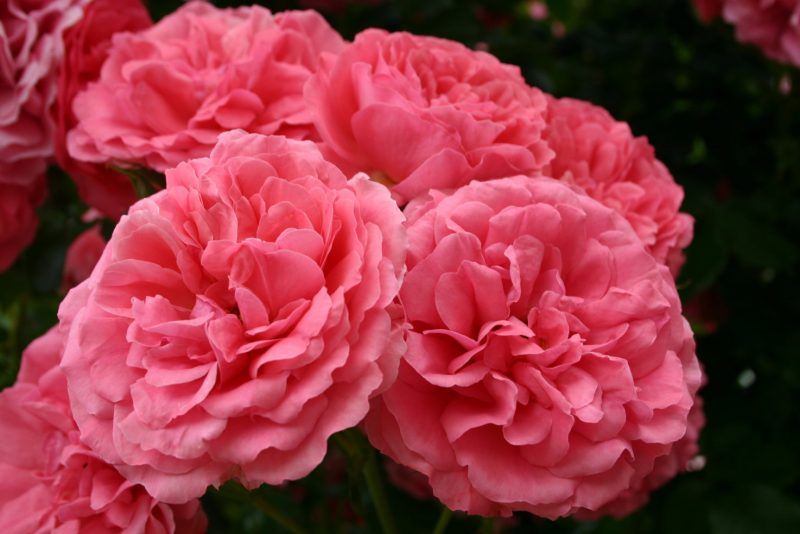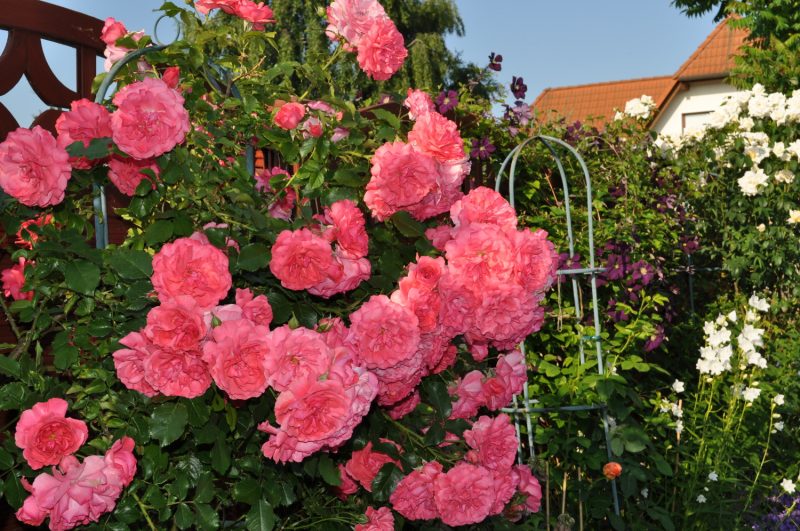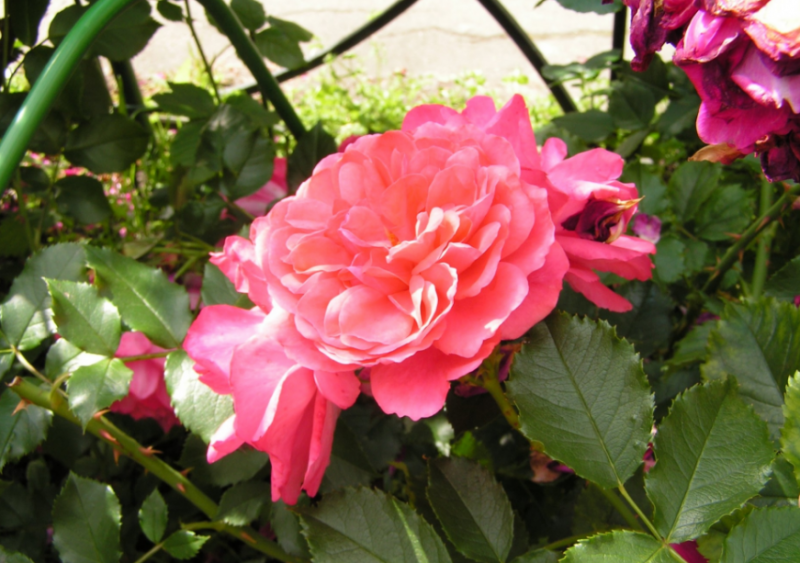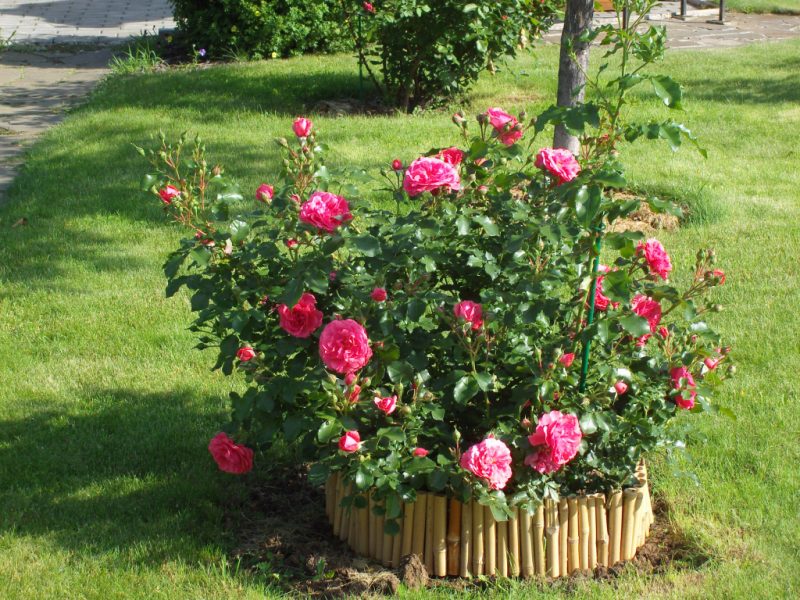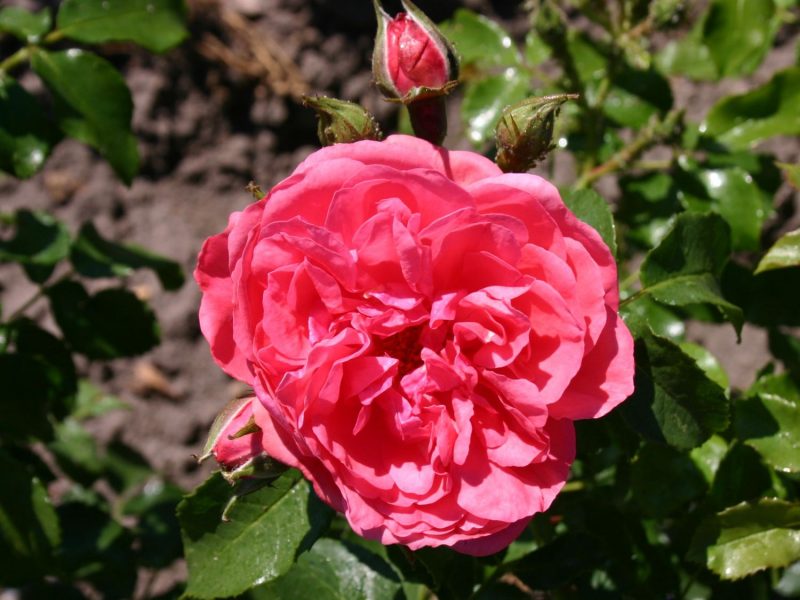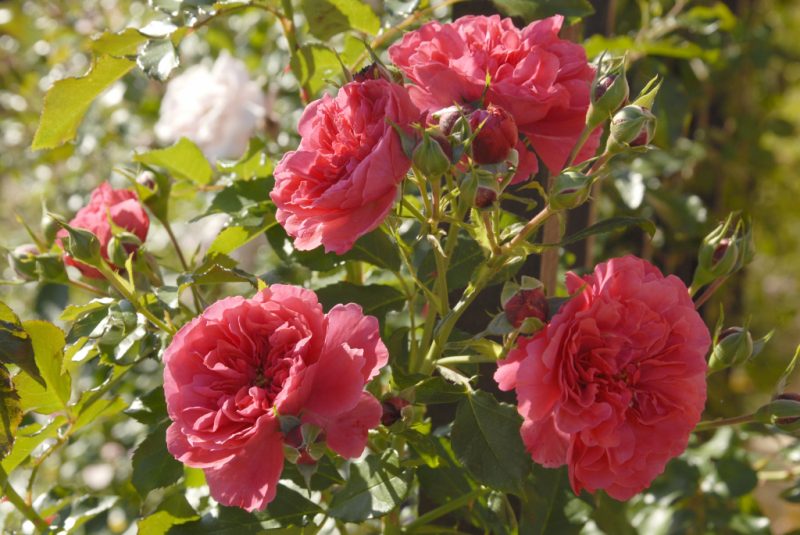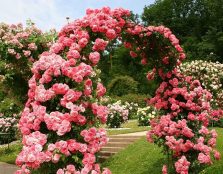Cultivate wild species of roses began a very long time ago. Already in the V century. BC. the gardens were decorated with several dozen varietal beauties. Since the XVIII century, breeding work began everywhere and their result was the emergence of many varieties, among which the rose Rosarium Utersen has been popular for over the past 40 years.
Material Content:
History of Rose Breeding Rosarium Uetersen
In order for the climbing rose Rosarium Uetersen to decorate the flower beds, several generations of the Cordesov family were engaged in breeding. The result was obtained only in 1977, when the German breeder V. Cordes presented the beauty to the general public.
Description of the variety and its features
Variety Rosarium Utersen is represented by roses with a height of 3 m from the group of Klimmers. The width of the bush formed by strong shoots, covered with glossy saturated green foliage, can reach 1.5 m. When flowering, which occurs the first time at the beginning of summer, and the second at the end of the season, single or gathered in the brush terry inflorescences with a delicate aroma . After a strong opening of the buds, the petals of a flower resembling a flat rosette acquire a silver hue. One of the important features of the variety is the resistance of the flowers to adverse weather conditions: they do not get damaged by precipitation or wind. Also, the advantages include a high decorative culture, resistance to colds and diseases, excellent ability to cope with insufficient care.
Outdoor landing
Proper carrying out of planting operations, including the choice of a place and its preparation, determination of optimal terms and other moments, is the key to excellent health and the enchanting beauty of flowers.
Site selection and soil preparation
Rosarium Uetersen feels good in sunny areas, protected from drafts and located on hills, where the depth of groundwater is at least 1.5 m. The soil should be quite light, loose and fertile with a 30 cm humus layer. to increase the fertility rate, it is recommended for digging, which is carried out in autumn or spring 2-3 weeks before planting, to add organic matter in the form of peat, wood ash, compost.
Timing and landing technology
The best planting time is in the spring, when the earth warms up to 10 ° C. In the southern regions, planting of seedlings in the autumn season is permissible.
When landing:
- Dig holes with dimensions of 70x70 cm.
- A drainage layer of pebbles is placed at the bottom.
- The roots of the planting material are inspected and dipped in an earthenware mash, after which the roses are lowered into the planting pits, into which the earth mixed with humus has been previously poured halfway.
- Seedlings are covered with the extracted soil so that the neck is deepened by 10 cm.
- The trunk circle is compacted and watered abundantly.
Agrotechnics of cultivation and care
The climbing rose is cultivated in different regions of Russia. But in order for it to remain highly decorative for many years, a competent approach to cultivating a plant is required.
Watering
In the absence of natural precipitation, the rose Rosarium Uetersen needs systematic irrigation at the rate of 10-20 liters of water under the bush. The volume varies depending on the age of the plant. Watering should be carried out in the morning or in the evening, using settled water at room temperature. The interval between water procedures during the active growing season is 5-6 days, during which the topsoil will have time to dry out.
Soil treatment
After 2 days after irrigation or heavy rainfall, trunks circles loosen, which ensures good air and water permeability. Of no less importance is the purity of the soil, which must be maintained by regular weeding. To save time on loosening and weed control, you can resort to such a technique as mulching. Peat, sawdust or compost are used as mulch.
Fertilizing and fertilizers
Rosa Rosarium Yutersen responds to systematic top dressing, which should include both macrocells and micro.
During the growing season for the full development of the rose bush, it is necessary to add at least 4 top dressings under it, which should include nitrogen, phosphorus and potassium:
- in the spring it is recommended to introduce nitrogen-containing agrochemicals that stimulate the growth of green mass;
- in summer, phosphorus and potassium should be part of the top dressings, which provide long and lush flowering;
- in early autumn, it is worthwhile to focus on phosphorus-containing fertilizers that help strengthen the immune system and a good wintering.
Protection against diseases and pests
Despite the fact that the variety is considered relatively resistant to disease damage and pest attacks, the manifestations of the following harmful organisms are often observed on beautifully flowering bushes:
- Aphid is one of the most dangerous parasites, which harms not only by drinking juice from the shoots, but also by the spread of infection of viral, fungal diseases. To cope with insects, it is recommended to resort to the most effective method - spraying with a broad spectrum insecticide.
- A spider mite is a pest observed in dry weather, which is most favorable for its development. During processing, it dies from aphids, since it is susceptible to the same substances as the above insect.
- Gray rot - intensive development is noted during waterlogging, which should be avoided for the normal development of the flower.
- Overexposure is a fungal disease, the foci of which are noted in rainy weather. To stop the development, it is required to treat the affected individuals with a fungicide.
Pruning roses, preparing for winter
The Rosarium Uetersen is not a ground cover rose. The wicker queen of flowers needs pruning and shelter for the winter so that she is guaranteed to winter well.
It is recommended to cut off damaged shoots before the onset of frost, and shorten all the rest by 20 cm. After the branches bind and bend. Above the bush, a frame of twigs is constructed, which is covered with non-woven material or spruce spruce branches. A full-fledged shelter is created only after the advent of frost so that the rose does not block.
The use of varieties in landscape design
The climbing rose Rosary Utersen in landscape design is used in the design of arches, arbors and other art objects, where vertical landscaping is appropriate. Such flowers will look equally impressive when decorating the central entrance to the house. In the case of a single planting, where it is planned to use the rose as a tapeworm, it is recommended to install the appropriate support, giving the plant more decorative.
The Rosarium Uetersen is a very beautiful rose, planting and care of which is possible even for beginners. When performing simple care measures, you can achieve a long and plentiful flowering, which will delight fans of the variety not only with the beauty of inflorescences, but also with a very pleasant aroma.


